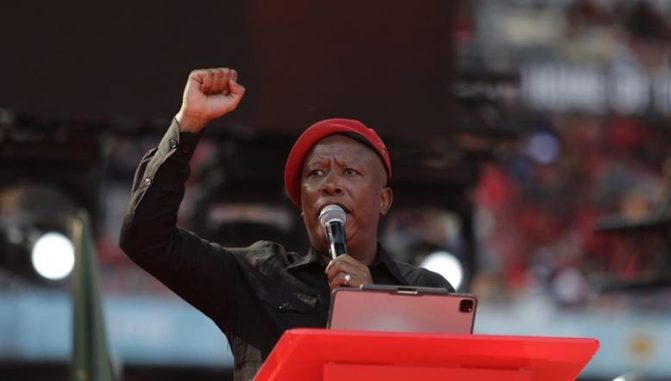
Julius Malema, leader of the populist, Marxist-inspired Economic Freedom Fighters (EFF), was seen chanting provocative slogans such as “cut the throat of whiteness” and “Kill the Boer, kill the farmer,” a historical anti-apartheid rallying cry in a video Trump played for South African President Cyril Ramaphosa
| Published May 27, 2025
The resurgence of the controversial “Kill the Boer” chant by Julius Malema, leader of South Africa’s Economic Freedom Fighters (EFF), has reignited debates on racial tensions and media narratives. This chant, originating from anti-apartheid struggles, has been a focal point in discussions about race relations in post-apartheid South Africa.
The Chant’s Controversy
In a recent speech, Malema ended his address with the chant: “Shoot to kill, Nyamazana! Kill the Boer, the farmer!” This phrase has been interpreted by some as a call for violence against white South Africans, particularly farmers. However, Malema and his supporters argue that the chant is a symbolic expression of resistance against historical oppression and not an incitement to violence.
Media Coverage and Political Reactions
The chant gained international attention when former U.S. President Donald Trump presented videos of Malema’s speeches during a meeting with South African President Cyril Ramaphosa. Trump characterized these actions as evidence of a “white genocide” in South Africa, a claim that has been widely disputed. Fact-checkers and South African officials have pointed out that such narratives are misleading and do not reflect the broader context of crime in the country. For instance, official data reported only six farm murders in early 2025, with one white victim. Furthermore, some of the footage presented by Trump was misidentified, including images from the Democratic Republic of Congo .
Despite these clarifications, the media’s portrayal of the incident has been polarized. Some outlets have labeled Trump’s presentation as an “ambush,” while others have criticized the media for downplaying the significance of the chant. This divergence highlights the challenges in reporting on sensitive issues where historical context and political implications are deeply intertwined.
Legal and Cultural Perspectives
South African courts have previously ruled that the “Kill the Boer” chant is not hate speech, recognizing it as part of the country’s struggle heritage. However, this legal stance does not preclude ongoing debates about its appropriateness in contemporary political discourse. The chant’s use by political figures like Malema continues to provoke discussions about the balance between freedom of expression and the potential for incitement to violence.
The implications of the “Kill the Boer” chant controversy and its global media coverage are significant across multiple dimensions:
1. Domestic Social Tensions in South Africa
-
Racial Polarization: The chant revives painful historical divisions, especially among white South Africans who see it as threatening, and black South Africans who may see it as symbolic resistance.
-
Political Capital: Leaders like Julius Malema leverage such rhetoric to galvanize support, but it risks inflaming tensions and eroding social cohesion.
-
Public Safety Concerns: Even if legally protected as political speech, the chant could embolden extremists or provoke retaliatory sentiment.
2. International Relations
-
U.S.-South Africa Relations: Donald Trump’s highlighting of the chant as “evidence” of white genocide may complicate diplomatic engagement, especially if perceived as interventionist or misinformed.
-
Reputation Management: South Africa’s global image may suffer, especially if narratives of racial violence dominate the discourse—even if not statistically representative.
3. Media Credibility and Bias
-
Trust in Media: The Zero Hedge article argues that mainstream outlets downplay or ignore issues that don’t align with their preferred narrative, suggesting ideological filtering.
-
Selective Reporting: Some media portray Trump’s remarks as a provocation rather than engaging with the core concern, reinforcing accusations of bias.
4. Legal and Cultural Interpretation
-
Freedom of Expression vs. Hate Speech: South African courts ruled the chant isn’t hate speech, but that doesn’t eliminate its divisive impact. The gap between legal protection and public reaction is wide.
-
Historical vs. Contemporary Use: What was once a liberation slogan now functions in a very different context—raising debates on whether its continued use is appropriate.
5. Global Political Narratives
-
Populism and Identity Politics: The situation plays into larger global themes—such as majority/minority power struggles, immigration debates, and “reverse discrimination” claims in Western politics.
-
Weaponization of Symbolism: Politicians worldwide might use South Africa’s racial issues as rhetorical fuel to advance their own agendas, often detached from context.
Overall Takeaway:
South Africa’s unresolved racial tensions are being amplified by both domestic political rhetoric and international narratives, often divorced from local context. While the chant is legally protected and historically symbolic for some, its use today stirs deep divisions and invites global scrutiny—especially when prominent foreign figures like Donald Trump frame it as evidence of a racial crisis. The media’s varied responses reflect broader concerns about bias, agenda-setting, and selective reporting.
Ultimately, this episode highlights the fragile balance between freedom of expression, historical memory, and the risks of political weaponization—both at home and abroad.
SOURCES: ZEROHEDGE – The Media Told You Over And Over That This Isn’t Happening…
AHRAM ONLINE – South Africa’s Malema vows to keep chanting controversial song
FIRSTPOST – South African oppn leader vows to keep singing song that Trump calls proof of ‘white genocide’



